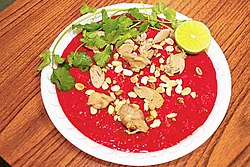Tiết Canh – Credit Wikipedia
#10,803
Although the exact moment and circumstances when SARS first jumped to humans in China – or Ebola to humans in West Africa – may never be known, high on the list of possible exposures is the consumption of `bushmeat’. So much so that early in both of these epidemics, local governments took steps to shut down bushmeat consumption.
The 2002-2003 SARS epidemic, which infected 8,000 people and killed nearly 800, was believed sparked by the slaughter and consumption of exotic animals at `wild flavor’ restaurants in Guangdong Province China.
We aren’t talking subsistence `bushmeat’ here, but exotic and expensive dishes prepared for the wealthy, including: pangolin, cobra, tiger, bear, monkeys, dogs, cats, bats, and palm civets.
Karl Taro Greenfield, the editor of Time's Asia edition during the outbreak, recounts the fascinating tale in his book The China Syndrome (which I heartily recommend). While civits were originally implicated, more recent research suggests they were (at best) intermediate hosts, as bats have been found to carry SARS-like viruses both in Asia and around the world.
Although China cracked down on `wild flavor’ markets and restaurants after the SARS epidemic, enforcement has been lax, and the trade continues, albeit not quite as openly as before. In the spring of 2014 China announced another crackdown, including stiff jail sentences for consumers (see Despite Crackdown, `Wild Flavor’ Trade Continues In China).
There are still local culinary customs in many parts of the world that potentially expose humans to potentially deadly pathogens.
In Vietnam, the local dish called Tiết Canh – or raw blood pudding – is one of them. The recipe varies – and while raw duck blood is most often used, other dishes may use pig blood, or even bat’s blood.
Despite aggressive campaigns to stop this practice by the Vietnamese government, stories like the following appear far too often in the local press:
Pudding, dish deadly
18:35 15/07/2015 Tropical Disease Hospital in Hanoi Central has received 5 cases of swine streptococcus infections (Streptococcus suis), including 3 who eat pudding, 2 cases were fatal. But do not spread into an epidemic but often did pudding singular death.
S. Suis is a particularly nasty, often fatal infection, and it’s link to the consumption of blood pudding was well covered last year in the CDC EID journal dispatch:
Raw Pig Blood Consumption and Potential Risk for Streptococcus suis Infection, Vietnam
Vu Thi Lan Huong
, Ngo Thi Hoa, Peter Horby, Juliet E. Bryant, Nguyen Van Kinh, Tran Khanh Toan, and Heiman F.L. Wertheim
Overnight, we’ve a variation on this theme, with reports of a recently retired local official dying after consuming bat’s blood pudding. First the story, then I’ll be back with a bit more.
Died of poisoning from eating pudding bat
By Tin Tức • On 14/12/2015
Died of poisoning from eating pudding bat after severe abdominal pain and diarrhea several times, the victim is the former director of a department in Bac Lieu. The incident is being investigated functional forces clarified.
Died of poisoning from eating pudding bat
According to information received from the General Hospital Phuoc Long district, Bac Lieu province, they have received a case of food poisoning, but the victim died.
The victim was identified as Mr. HMH, 59 years old, live in the town of Phuoc Long, former director of a department in Bac Lieu and his new H received the decision to retire a few months ago.
Known on the evening of 11/12, Mr. H had a party and invite friends to the house together. He was entertaining friends with duck meat and bats bats. But when people are happy eating, he suddenly H severe abdominal pain and on the toilet, diarrhea several times. When people see him on the toilet for too long not to be seen in the new look shocked to see the home defeat at the toilet.
Upon discovery of the incident, the family took him to the Hospital H Phuoc Long district emergency but the victim died on way to hospital.
(Continue . . . )
Regardless of the cause of this unfortunate diner’s death, if you want to afford a zoonotic pathogen easy access to a human host, the consumption of blood pudding is probably as good as it gets. In addition to frequent S. Suis infections (see A Streptococcus suis Round Up), we’ve also seen anecdotal reports of H5N1 contracted from these types of dishes.
The past decade has been a good one for Chiroptologists (scientists that study bats) worldwide, as each year we seem to learn of new (and potentially zoonotic) diseases these ubiquitous flying mammals can harbor.
Beyond Rabies, Nipah and Hendra, bats are now known to carry a wide array of coronaviruses, several novel flu viruses, and even hemorrhagic fevers like Ebola and Marburg. And unlike the avian influenzas, the viruses that bats carry are already mammalian adapted, presumably making them more likely to infect humans.
While we wait and watch for signs that one of the avian influenza viruses (H5N1, H5N6, H10N8, etc.) has evolved into a more `humanized’ pathogen, the reality is there may already be a suitable pandemic candidate residing quietly in a bat, just waiting for an invitation for dinner.
